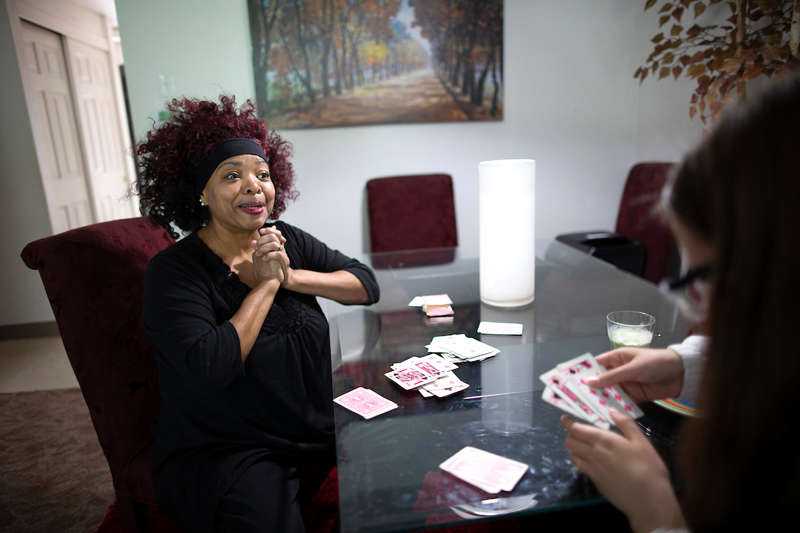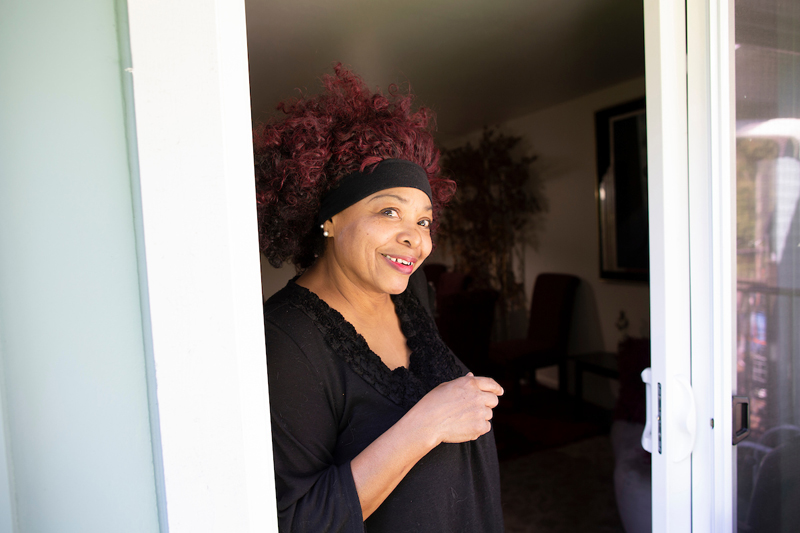Nataya Foss remembers being told that she would soon have to leave the shelter. She had been staying in one of Washington state’s few shelters for unaccompanied homeless minors, but because of restrictions that come with government funding, the shelter could house her for only three weeks. Her time was almost up.
“Definitely it was scary,” said Foss, who was 17 at the time. “I was like, ‘Where am I going to live? What am I going to do?’ I was kind of just in free fall.”
When Foss returned to the shelter, Cocoon House in Everett, after a few precarious weeks of couch surfing, she connected with one person who made a big difference: a case manager who stuck with her through the remainder of her homelessness. Even after Foss returned to live with her family, who also had been homeless, her case manager was there for her, she says.
That consistency is “so important when it comes to youth homelessness, because you are so truly out of control,” said Foss, now 21 and a recent Everett Community College graduate.
Typically, youths change case managers, therapists and schools each time they hop between short-term shelters, bounce back onto the streets or surf among friends’ couches.
“We’re teaching our youth to have attachment disorder” with all these changes in the adults supporting them, said Rachel Mathison, director of programs for Cocoon House. “If they don’t come to us with a distrust of adults, they are going to leave with it.”
Foss wanted to change that. As chair of a Snohomish County, Wash., youth homelessness advisory committee, she advocated for a new program that allows case managers to stay with teens through each move, and even after they return home. Called Youth Permanency Navigators, the program will launch by the end of this year.
Youth Engagement Team
The Snohomish effort — and a similar program started in King County, Wash., last October — are experiments in new ways to help homeless youth under age 18. These adolescents are especially vulnerable to becoming victims of assault, sex trafficking and other crimes while on the streets, yet they have few options to obtain stable housing. Many are falling through the cracks, advocates say, increasing the odds they will face homelessness as adults.
Both of Washington’s new initiatives, funded by recent grants from the U.S. Department of Housing and Urban Development, are being launched as communities around the country are struggling to address homelessness among youth under 18.
“How we build systems for young people under 18 experiencing homelessness is the national challenge in the [youth homelessness] movement right now,” said Megan Gibbard Kline, director of A Way Home America, a national coalition of groups working to end youth homelessness.

Photo by Dorothy Edwards/Crosscut
Nataya Foss is the chair of the Snohomish County Youth Action Committee, which provides oversight for the county's federally funded Youth Homelessness Demonstration Program. She experienced homelessness when she was 17.
Her group recently surveyed 23 communities around the country about their efforts to address homelessness among minors. “Near as I can tell, there is not anybody that has really figured this out just yet,” Gibbard Kline said.
In the state, the total number of homeless minors and families fell by just under 5% in 2019, according to the most recent statewide point-in-time count, with the biggest drop in King County. Among the half of counties that saw increases, Snohomish and Clark counties showed some of the sharpest jumps. Nationwide, an estimated 700,000 teens under 18 experience homelessness each year.
Many youths become homeless soon after exiting the juvenile justice system, foster care or mental health and substance abuse treatment, and Washington has vowed to halt that trend by the end of 2020.
To help achieve that goal, the Snohomish program will embed a permanency navigator with the county’s juvenile court, where an estimated 360 youth a year are homeless or at risk of homelessness, a recent study found. An additional three full-time navigators will work with youth in child welfare, schools and mental health care.
King County’s new program for homeless minors, called the Youth Engagement Team, is testing a different approach by addressing common causes of youth homelessness, such as conflict at home, family homelessness and legal barriers to stable housing. The program consists of two teams, each with a licensed mental health counselor, a housing navigator and a lawyer. Similar to the Snohomish program, youth work with the same team members for the entirety of their involvement, which lasts up to six months.
The two-year King County pilot, with a budget of $857,000, planned to serve at least 100 youths a year. It has already served more than that in the first nine months, according to All Home, the county’s homelessness coordinating body, which oversees the program.
Neither the King nor Snohomish programs creates additional long-term housing for minors. That remains a barrier to success, program leaders say.
Reuniting homeless kids with family can take longer than the few weeks shelters typically allow minors to stay, according to shelter managers. For those who can’t go home, the state has only about two dozen long-term transitional living spots. As a result, Youth Engagement Team leaders say they often must scramble to find “creative solutions” to house minors, such as enlisting a family friend to host a child or pushing the state to place a youth in foster care.
When mom is homeless too
Like many youths who enter the Youth Engagement Team, Jo came to the program last fall after her family became homeless. Living with her mother in a shelter would have forced the academically inclined 16-year-old to change high schools.
Instead, Jo, who requested that only her middle name be used, moved into the South King County apartment of LaTonya Pratt-Shelby and her daughter, who is friends with Jo. Pratt-Shelby said she knew Jo was “a good kid” when she agreed to serve as what’s called a “host home” through Accelerator YMCA in Seattle, which manages one of the Youth Engagement Teams.
Now the three women share two bedrooms and one bathroom with a calico cat and a goldfish. Pratt-Shelby receives $350 each month to help with food and other expenses. She’s never had to call the 24-hour number the Youth Engagement Team provides in case any problems arise.
One sunny afternoon this May, Jo returned to the apartment after school. After a quick hello, she declared, “I’m gonna eat.” Pratt-Shelby had a ham-and-cheese sandwich waiting for the hungry teen.
As Jo finished her after-school snack, her case manager from the YMCA arrived for their weekly meeting. Today they were headed to the local mall to buy Jo some T-shirts and shorts for summer. The program pays for basic clothes, toiletries and other necessities. Other weeks, the case manager takes Jo to driver’s education classes, helps her look for a summer job or just catches up with her over a Starbucks Frappuccino.
Jo said she appreciates that Youth Engagement Team members check in with her every week, something that didn’t happen during an earlier period when she was in foster care. And normal teen milestones like earning a driver’s license “would have been a lot harder” without their help, she said.

Photo by Karen Ducey
LaTonya Pratt-Shelby plays cards with a teen after she comes home from school. She receives $350 each month to help with food and other expenses.
With assistance from the Youth Engagement Team, Jo’s mother should soon have her own apartment, and Jo will move back in with her. The program can help clear eviction debt and pay in move-in costs, up to about $2,500.
But, like other efforts to tackle homelessness in the region, the program is hampered by a shortage of affordable housing. A Washington worker must earn nearly $28 an hour to afford a two-bedroom rental, according to the National Low Income Housing Coalition. Even with the program’s assistance, many families can’t afford a space that meets their needs, and a child might be forced to sleep on the couch, one housing navigator said.
As both Jo and Foss experienced, it can take months for families to stabilize. In the interim, youth often have to hop among shelters, friends and relatives, making staying in school nearly impossible.
Host homes offer one of the few longer-term options available to homeless minors, but they are not yet a solution for teens who don’t have a friend or extended family member willing to participate. So far no families have signed up to take in minors they don’t know, according to Accelerator YMCA, which started its host home program in 2016.
Getting kids home
Reuniting kids with a parent or guardian is the only permanent solution for most homeless minors. But it often isn’t easy or quick, program leaders say. The Youth Engagement Team is testing whether employing a licensed therapist can help.
Most youths in a new study by Chapin Hall at the University of Chicago said their homelessness was a result of fighting or violence at home that eventually led them to run away or get kicked out. Nearly half the 215 young people interviewed said they had faced stigma from family members, often because of their sexual orientation or gender identity. By the time youths become homeless, society has missed many opportunities to intervene with them and their families, the report concludes.
After years of conflict, both kids and parents often resist reconciling, said Flaminia Cohen Tuval, a licensed adolescent and family therapist with Friends of Youth in Kirkland, Wash., which manages one of the Youth Engagement Teams. While parents love their kids, she said, they “can’t stand their behaviors, so they kind of give up on them.”
With the permission of a minor in the program, Cohen Tuval can involve parents and siblings in therapy. She remains available to mediate after youths go home, or if they go live with relatives who may be ill-prepared to raise an adolescent.
It’s not unusual for kids to run away again, she said. “Sometimes you just plant seeds for the future.”
For some, going home isn’t an option. Some youths have been abused or abandoned, and in other cases parents refuse to let them return. In such cases, a lawyer can help.
The Youth Engagement Teams include attorneys from Legal Counsel for Youth and Children, who have helped teens in the program set up legal guardianships and get emancipated, and have pushed Child Protective Services to take children into foster care. They also help clear warrants that keep kids on the run.
For minors who can’t reunite with family, the state needs more long-term, supportive housing, advocates say. But such residential programs are expensive, and federal funding for them hasn’t budged for more than a decade. The 21-day limit for federally funded shelter stays should also be extended for certain youth, including those whose families are homeless, the recent Chapin Hall report recommends.
Hopefully, the Youth Engagement Team will “draw attention to the glaring lack of resources for young people under 18,” said DeAnn Adams, who supervises the team managed by Friends of Youth.
Kids treated like ‘hot potatoes’
Helping individual kids navigate disjointed, under-resourced systems will never solve youth homelessness, experts say.
Homeless minors “are often treated like a hot potato,” tossed between homeless youth programs, juvenile detention and child welfare, said Darla Bardine, executive director of the National Network for Youth. Those systems need to collaborate better, she and others argue.
Young people also should have more autonomy to decide what they need, she added.
Foss, the formerly homeless youth, agrees. She still speaks with frustration about the condescending attitude she encountered from adults, who offered a lot of advice but rarely asked what she needed.
“They both blame you for being in your situation, while also never providing you with the resources to get out of it,” Foss said. “And at the same time, you're a youth. You have very limited rights.”

Pingback: Washington State Tries Host Homes, Permanency Navigators for Homeless Teens – Juvenile Justice Information ExchangeJuvenile Justice Information Exchange – Bofield8 Engaged Consulting